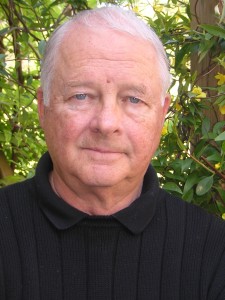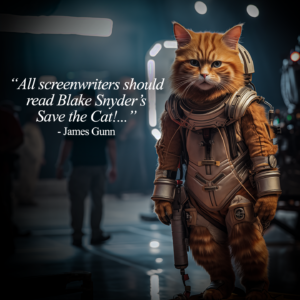
William Neal Harrison is co-founder of the program in creative writing at the University of Arkansas. He wrote the original Rollerball, as well as Mountains of the Moon and A Shining Season for television. It is an honor to have this original piece from him.
All good storytelling is a series of surprises. Movie surprises are essentially visual. But when characters speak, the dialogue should surprise too.
Settings, Characters, and Events Create a Narrative
Movies rely on scenes, a chronological flow of events known as plot, what happens. When arranged cleverly, the scenes have an unexpected quality and they entertain us with their verve, their reversals, and their spontaneity. We can’t anticipate what’s coming next. In King Kong, who could guess that the giant ape is called out of the jungle to claim a blonde? Who could guess that he becomes her protector? Who could guess that she discovers a soft spot in her heart for him? From that classic adventure movie to all the modern remakes, the thrills are piled on: new twists, new visuals, constant surprises.
Characters usually first appear as stereotypes, but the truly great ones change, grow, expand, and surprise us. It is the shy and seemingly normal Michael Corleone who volunteers to murder the crooked cop and threatening gangster in The Godfather. His unexpected courage evolves into new leadership, and many dimensions in him soon become apparent.
Settings that seem incidental become organic in the best movies. Viewers then understand, hey, this couldn’t have happened anyplace else — or at any other time. There is no Lawrence of Arabia without the desert. David Lean’s film opens up surprise after surprise as the imagery becomes a dominant presence. There is something barren and hard in the desert that echoes in the characterization of Lawrence himself.
Dialogue Merely Nudges the Plot Forward
As Pulp Fiction opens, two hit men — we don’t yet know they’re killers — ride in a car and talk about hamburgers. One of them has just come back from Paris, and he talks about the names of burgers at McDonald’s in France. Soon they park and begin to take weapons out of the car trunk. They go up to an apartment where they confront some young men who robbed their boss. The leader of the young gang, terrified as the hit men enter with their guns drawn, is eating a burger. A hit man asks for the burger, bites into it, and comments on it. Finally, he begins his threat in a burst of Biblical language that reveals his anger. Throughout the scene, the dialogue swings from seemingly idle commentary to strong menace. There’s humor, casual observation, and implied threat. Then another young gang member enters with his weapon and opens fire — and his bullets all miss the mark.
Dialogue never tells the story. In this famous opening, dialogue nudges the plot forward, but the scene is shown, not told. Ideally, dialogue should never comment on the action at hand or what just happened — and it should remark very little on what’s coming. At best, it becomes a facet of characterization. It shows if a character has intelligence or not. If he’s a wit or witless. If he’s capable of irony. It often sets up a rich counterpoint to the action: the characters are doing one thing yet talking about another. This happens all through Pulp Fiction.
The essence of comedy is often a character’s wrong assessment of what’s going on.
Explanation Is Unnatural
A writer has a problem when things need to be explained:
How does the machine work?
What are the clues left by the serial killer?
What’s the plan?
The superb answer is: don’t explain much. Exposition is the enemy of cinema, so look for visual solutions.
Lawrence broods all night in the desert while his two young servants watch him. The music becomes part of his torment. Time passes. Then he says one word: “Aqaba!” Is it a curse? A secret word? No, it’s a place where the enemy’s big guns are pointed out to sea, making it vulnerable by land — if men can suffer the ordeal of crossing the desert in order to attack. But we learn this in the scenes that follow — scenes with stunning visuals.
Watch the great films: Casablanca, Cabaret, Some Like It Hot, The Graduate, Bonnie and Clyde, Dr. Strangelove, Patton — or films by Hitchcock, Fellini, Bertolucci, and other giants — by way of seeing how dialogue is used. Watch some of the minor masterpieces too: The Duellists, The Long Goodbye, or Paper Moon.
Good dialogue makes us laugh or startles us or causes us to suddenly reflect. It provides nuance to this great American literature of film. We have to study it and understand how it differs sharply from the theater, the novel, and other literary forms and how it offers its own surprises.
Next week: Guest blog from novelist Jenny Gardiner
BJ Markel
5 Comments
Leave a Reply Cancel reply
You must be logged in to post a comment.









Bill Harrison hits his target every throw. I joined the Arkansas graduate writing faculty with a half-dozen books, but didn’t know a thing about how I wrote them. I have been Bill’s colleague, yes, but more his student. And I still hear his voice over each line I write. A brilliant and gifted teacher, also writer, and one of the finest people I’ll ever know, dammit.
This is amazing. Thank you for sharing!
Goodness, now I have more to wrap my brain around!!
Awesome!
lovely, and spot on… thank you. babz
Thanks for this week’s article. How does a writer develop subtext without creating confusion or burying it so deep that it drowns? Any books, articles or exercises you could recommend?
When I was in the Marine Corps the drill instructors were quite fond of acronyms, and ironically enough one of their favorites was KISS. It didn’t stand for anything as pleasant as you might guess. But it’s helpful, nonetheless. KISS: Keep it simple stupid. It meant, don’t make things hard on yourself. In writing, we’re often our own obstacles, and we just need to get out of the way. A great modern master of this kind of story-telling is Christopher Nolan, who seems to make a habit of getting away with murder, or rather cloning and then murder in The Prestige, through the use of quite simple images. No need to explain too much. For instance, after we see the opening sequence of Inception we know how the world works. The water is pouring into the dream world because the guy strapped to the chair is being pushed into the bathtub. It sounds as simple as a college prank, but who can forget that slow motion fall backward into the tub as the water pours in through the windows of DiCaprio’s consciousness? To top it off, that water imagery is re-used in the third act climax, when the van is driven off the bridge into the river… That’s right, Nolan is saying, we can not only enter into another’s consciousness and manipulate it by altering the fabric of their dreamscape… but we can escape on demand with the help of this complex doodad called…well…a wooden chair. Complex stories told simply. KISS. Gotta love it.
http://word-is-bone.blogspot.com/